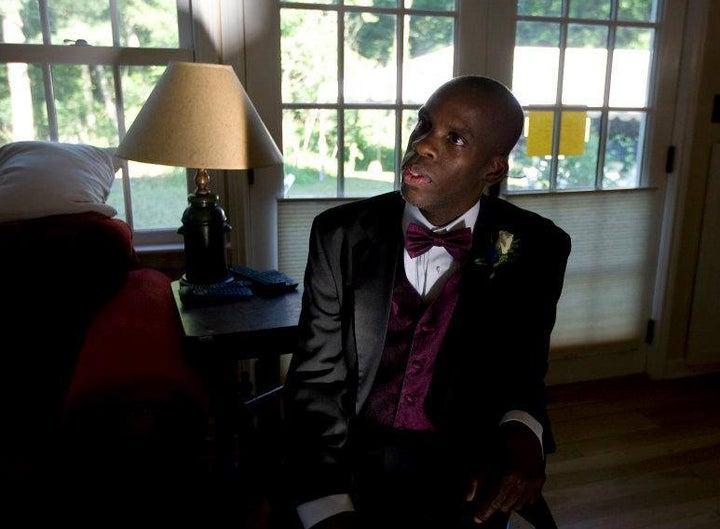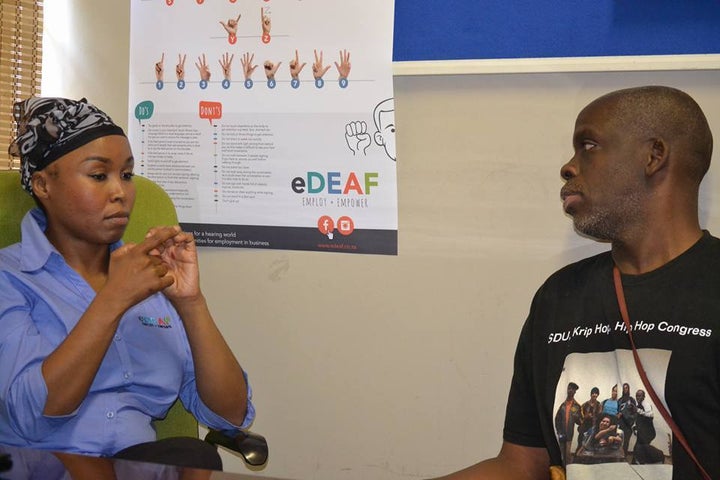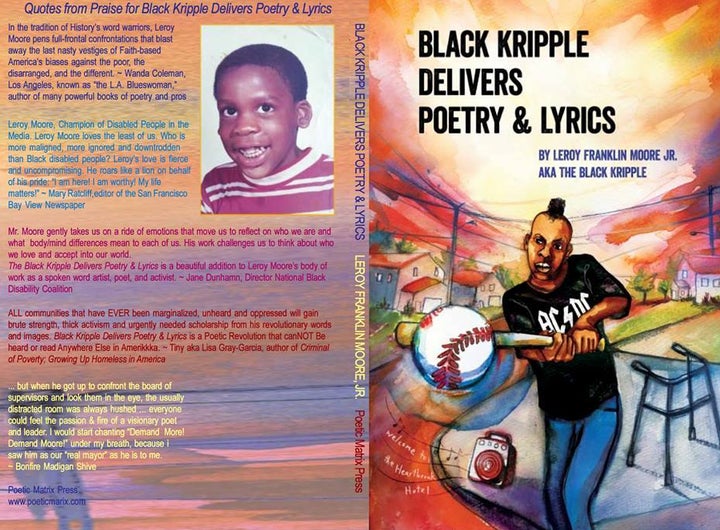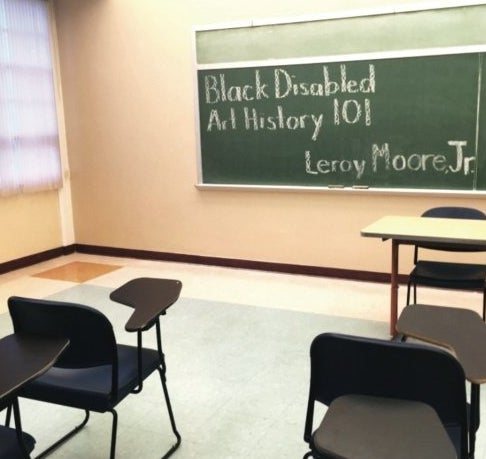Leroy Moore Jr. has been advocating for the rights of people with disabilities in the black community for decades. One of his advocacy projects involves promoting the music of artists and musicians with disabilities in the Black and “Brown” communities. He refers to this music as “Krip-Hop” and has been around the world, most recently in South Africa, meeting with artists and musicians with disabilities.
On June 2, at the Whitney Museum of American Art in New York City, Moore will be discussing his advocacy work and how oppression and ignoring Krip-Hop in our culture is undermining the contribution these artists are making to music and art. Moore is the author of The Black Kripple Delivers Poetry & Lyrics, published by Poetic Matrix Press in 2015 and his forthcoming children's book, Black Disabled Art History 101, will be published this summer by Xóchitl Justice Press. He was also the co-founder of the Sins Invalid performance project.

This is a Q&A with Moore about his activism work:
Question: How did you get invited to the Whitney?
Moore: The Whitney called me to ask about a controversial exhibit. The one about the white, woman artist and her painting of lynching victim Emmett Till that was on display in March. [Moore is referring to Brooklyn-based artist Dana Schutz whose work called “Open Casket,” shows the savage lynching of Emmett Till. At just fourteen, Till was lynched in 1955 after being falsely accused of harassing a white woman. Schutz’s work went on display at the opening of Whitney’s Biennial in March. But Black artists and others protested because they felt a white person should not be depicting black injustices at the hands of white people. [A recent story from the Washington Post explains the outcry over the painting and Ms. Schutz talks about the reaction over her painting.]
The original ask was to have Sins Invalid and Krip-Hop Nation perform. However, after talking with Sasha Wortzel [Whitney’s Director of Access and Community Programs] about Krip-Hop Nation and our new presentation, Black/Brown International Disability Art and Hip-Hop, Sasha thought it would be great to have a performance and presentation from the Krip-Hop Nation. I’m also really thrilled to have artists Carolyn Lazard, Park McArthur and Constantina Zavitsanos join me in the discussion.
The presentation will also look at the state of abuse against Black/Brown disabled people like Emmett Till, who had a speech disability. However, his disability was erased from his case.
Q: Tell me about some of the Krip-Hop artists you have met and what the Nation is about?
Moore: The Krip-Hop Nation’s mission is to educate the music and media industry, was well as the general public about the talents, history, rights and marketability of Krip-Hop artists. I started it in 2007 and have since been all over the world meeting disabled artists in countries such as Brazil, Spain and New Mexico. I’ve been connecting with disabled activists and artists for years now. I recently came back from a trip from South Africa. I met all kinds of artist, actors and poets.
This past December I met South African activist Simon Manda, the co-founder of THISABILITY, a South African newspaper covering the disabled community. The newspaper is one of the oldest newspapers covering the issues of South Africans with disabilities. We met on Facebook in 2014 and kept in contact and so when I finally got a chance to meet him in person – amazing. We planned a tour where we would visit places such as Durban, Pretoria, East London, Port Elizabeth and Cape Town. We interviewed many disabled, including deaf artists, including the first deaf South African woman actress on mainstream television, Simphiwe Mkhize, who now works at eDEAF Center in Johannesburg. We’re planning another trip in fall 2018.


Q: What has held back Krip-Hop and has its time come?
Moore: Krip-Hop Nation has been networking with musicians with disabilities for nearly a decade. There are so many obstacles to connecting with musicians with disabilities. Here are some of them:
1. The cost. Living on SSI [Supplemental Security Income] international traveling is really a dream for many of us.
2. The inaccessibility of traveling on airlines. Airlines have a history of breaking wheelchairs and lately physically abusing passengers: There are stories about elders being dragged off the plane to people with disabilities waiting for hours for wheelchair assistance, etc. [The Los Angles Times, for instance, reported on a story in 2015 when a man crawled off the plane because there was no wheel chair when he landed.]
3. SSI also has rules that you can’t be outside the U.S. for more then a month.
Although it took Krip-Hop Nation ten years to get to South Africa it also gave us more time to connect with more artists with disabilities. Building a network before actually traveling to meet these amazing artists also allowed the Krip-Hop Nation to connect with a dedicated person that had the same vision of Krip-Hop Nation. This person was Manda. So what I learned from this process is to not only believe in what you do but always push it.
Q: How have your views about your work changed over the years?
Moore: More and more I have turned my view outside the United States. I am taking on a more global view of people with disabilities, especially in Black/Brown countries. Many reporters outside the U.S., especially in Brown countries, see disabilities through poverty, charity, war, right-wing governments and state discrimination. They need to look at how our government is supporting a lot of these right-wing governments in Black/Brown countries. The sad thing is that people in the U.S. don’t see the common thread of oppression that we are now feeling. They also don’t see the art and culture coming out of these Brown/Black countries. Here in the U.S. we may soon feel what it’s really like to live in an oppressed “regime” and what it’s like to live with no safety net. Under Trump, we are expecting sizeable cuts in disability benefits and the criminalization of poor people with disabilities on the streets.
Q: Tell me about your children’s book and what inspired you to write the book?
A: Black disabled and deaf artists have always existed. They were on the street corners down South singing the Blues, spray painting on New York subways and bringing sign language to the big screen. Today, young Black disabled artists are finding their own way to the stage and studio, some with a paintbrush in hands and on the big screen like Kei’Arie “Cookie” Tatum, and some with a drumstick in their hands, like Vita E. Cleveland. As a Black disabled youth in the 1970’s and 1980’s, I wished there was a book like mine because I wouldn’t have felt so different or perhaps isolated. So I am real happy about my children’s book being published.
The book is called Black Disabled Art History 101 and it tells stories about Black painters, dancers, musicians, actors and actresses with all types of disabilities from early 1900’s to today. We found some great pictures of the artists and illustrations drawings by Asian Robles and original poem-stories of Black disabled artists. There’s a poem I wrote in the late 1990’s about Black disabled art history in the U.S. that gave me the idea for the book. The book is slated to come out in late September 2017.

Q: Are things getting better or worse for people with disabilities?
Moore: Under Donald Trump they are expected to get worse. But life was already difficult prior to Trump, especially for people of color with disabilities. Now with all the budget cuts under the new administration, things are going to get worse. For me and many other people with disabilities who rely on state and federal assistance for housing and medical assistance it’s a complicated system. What is more painful to see is that our social and activist movements really don’t seem to listen and include people with disabilities. The movements need to add disability justice to their framework to fight police brutality and to fight raising the income of people living with disabilities. This awareness is missing in our country and around the world. This missing link can be added when movements travel around the world to connect with similar movements and this helps improve our visibility and brings justice to uprisings such as in Bolivia, the Congo and Brazil. There is a lot of police brutality against people with disabilities, not only in our country, but also in these developing countries. So collectively, we all need to push for more visibility and benefits. Moreover, it’s painful to admit, but we need members of our own community and movements to stop oppressing us.
[The Center for American Progress estimates that “15 million people with disabilities, including children and seniors, would be at risk under President Trump’s and House Republicans’ proposed Medicaid cuts. “Many could be pushed out of their homes and into costly and isolating institutions as a result. But that’s just the tip of the iceberg.”]
There is also the education aspect. The administration, and oh God, Betsy DeVos [Secretary of Education], are clueless about education for children with disabilities. There are reasons why we have certain laws and they want to eliminate them and remove the oversight. [The administration is expected to cut Education Department's funding by more than 13 percent and slash overall funding by almost $11 billion, according to the Center for American Progress.] Trump and DeVos appear to have little knowledge of the protections provided by federal law [Disabilities Education Act, or IDEA].
Although we can point to our government and DeVos about privatizing our public schools and opening charter schools, we must also pressure our own Black wealthy artists from the Hip-Hop industry and our high-profile leaders to fight for better education.
Q: Any last thoughts?
Moore: Although my presentation and performance at the Whitney deals with the Hip-Hop art of Brown/Black disabled people internationally, it also covers how the state treats people with disabilities around the world and how people with disabilities are connecting through our art and music and talking about our stories through oppression, invisibility and cultural appropriation. I finally think we are coming to a place of acceptance and pride. And so to go back to how we started the conversation and how the Whitney invited me to speak – it was about the Black and Brown community being outraged about a white artist depicting our struggles. Many Black and Brown artists have been telling these stories for a long time, so perhaps it’s time to take notice.
